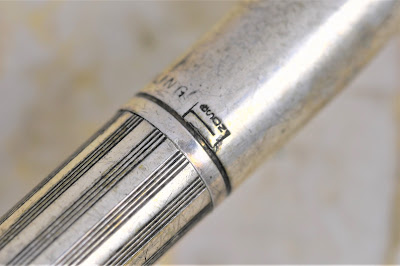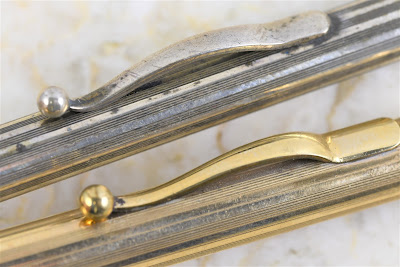This article has been edited and included in The Leadhead's Pencil Blog Volume 6, now on sale at The Legendary Lead Company. I have just a few hard copies left of the first printing, available here, and an ebook version in pdf format is available for download here.
If you don't want the book but you enjoy this article, please consider supporting the Blog project here.
Yeah, sometimes I spend books rather than selling them.
This one looks a lot more modern than the sort of stuff that usually interests me, but it’s a missing piece to a puzzle I’ve been working on for years. The accommodation clip on this sleek, modern looking broker’s pencil is marked “Victorian”:
Sort of an odd, traditional and frilly name on a modern skyscraper of a pencil . . . and the composition – that two-tone mix of chrome-plated steel and nickel silver at the nose. One might think at first this has been hacked together from parts, especially coupled with an accommodation clip that might have been swapped over from something else. I don’t think so, however:
The Victorian name also appears on the nose, a very traditional place to find a maker’s mark on a broker’s pencil, even though “nickel plate” isn’t a very traditional material at all for this sort of thing.
“Victorian” is a maker that I’ve had a hard time finding decent examples to add to the museum. On the whole, they tend to be made from thinner materials, so they dent more easily. The plating is also thinner, so they tend to look a little cruddier. I did find this example, a stubby (four inches or so) broker pencils – I think Paul Erano had it:
Note the long, straight ball clip with two rivets, classic design elements you’ll see on other pencils in the Hutcheon/Todd/Hicks family. And this one also has a very traditional imprint:
. . . accompanied by a cute little crown for a hallmark:
What I’ve always wondered is if there is some connection between the Victorian and the gold filled example in this next shot:
The sterling silver example bears LT & Sons’ hallmark:
The imprint on the gold filled one reads U.S.A. “Victor”:
Both share the turned up ball clips, which LT & Sons inherited from Edward Todd and Hicks.
So does the Victorian trace its lineage honestly back to the Edward Todd/Hicks progenitors of this family? Was it originally named the “Victor” then later modified to “Victorian” to give it a bit more traditional feel? Even later, was it given the appearance of something modern with an outer shell made from newer (and cheaper) materials and a sleeker (and cheaper) accommodation clip?
It’s like something new, impersonating something old, impersonating something new. Huh. If you haven’t seen the movie “Victor/Victoria,” look it up – the title of this article wrote itself.











No comments:
Post a Comment